Method for Evaluating Urban Building Renewal Potential Based on Multimachine Learning Integration: A Case Study of Longgang and Longhua Districts in Shenzhen
Abstract
1. Introduction
2. Materials and Methods
2.1. Study Area
2.2. Research Data
2.2.1. Data Collection
2.2.2. Selection of Evaluation Factors
- Building census data
- 2.
- Main and secondary road distances
- 3.
- Regional Support Data
- 4.
- Raster Data
2.3. Research Method
2.3.1. Data-Driven Models
2.3.2. Spatial Kernel Density Analysis
2.3.3. Evaluation Metrics Contribution Quantification
3. Experiment Process
3.1. Sample Selection
3.2. Data Correlation Analysis
3.3. Multimodel Fusion: Stacking Ensemble Learning
4. Results
4.1. Model Accuracy Comparison
4.2. Urban Renewal Prediction Results
- a.
- Urban Renewal Evaluation Analysis
- b.
- Evaluation Metrics Contribution Quantification
5. Discussion
5.1. Prediction Results and Spatial Kernel Density Validation
5.2. SHAP-Driven Policy Recommendations
5.3. Uncertainty Analysis
6. Conclusions
Author Contributions
Funding
Data Availability Statement
Conflicts of Interest
References
- Luo, Z.; Li, Y. New Urban Industry: Causes, Connotation, Characteristics, and Development Strategies. Reform 2024, 10, 90–106. [Google Scholar]
- Guan, C. New Characteristics of China’s Urbanization Process. People’s Trib. 2023, 2, 62–65. [Google Scholar]
- Carmon, N. Three generations of urban renewal policies: Analysis and policy implications. Geoforum 1999, 30, 145–158. [Google Scholar] [CrossRef]
- He, S. Two waves of gentrification and emerging rights issues in Guangzhou, China. Environ. Plan. A 2012, 44, 2817–2833. [Google Scholar] [CrossRef]
- Wu, Y.; Galdini, R.; Hui, E.; Long, H. Urban regeneration and re-use: China and Europe. Cities 2020, 106, 102863. [Google Scholar] [CrossRef]
- Deng, Y.; Qi, W.; Fu, B.; Wang, K. Geographical transformations of urban sprawl: Exploring the spatial heterogeneity across cities in China 1992–2015. Cities 2020, 105, 102415. [Google Scholar] [CrossRef]
- Boyko, C.; Gaterell, M.; Barber, A.; Brown, J.; Bryson, J.; Butler, D.; Caputo, S.; Caserio, M.; Coles, R.; Cooper, R.; et al. Benchmarking sustainability in cities: The role of indicators and future scenarios. Glob. Environ. Change 2012, 22, 245–254. [Google Scholar] [CrossRef]
- Yang, P. The connotation logic and practical orientation of urban renewal from the perspective of high-quality development. Mod. Econ. Sci. 2023, 45, 59–73. [Google Scholar]
- Yu, J. Urban Renewal: A New Milestone in Urban Development; National Academy of Administration Press: Beijing, China, 2011. [Google Scholar]
- Martin, F.; Ryan, M. The Death and Life of Great American Cities; Macat Library: London, UK, 2017. [Google Scholar]
- Mumford, L. The City in History: Its Origins, Its Transformations, and Its Prospects; Houghton Mifflin Harcourt: Boston, MA, USA, 1961. [Google Scholar]
- Wang, S. Refection on the “Three-Old” Urban Renewal Direction in Guangzhou Reconstruction Policy and Exploration of. Nat. Resour. Inf. 2018, 5, 51–56. [Google Scholar]
- Xiao, M. Research on Civil Law Issues in Urban Separate Ownership Residential Buildings Renewal. Master’s Thesis, Southwest University of Political Science & Law, Chongqing, China, 2024. [Google Scholar]
- Andrew, T. Urban Regeneration in the UK; Routledge: London, UK, 2013. [Google Scholar]
- Yang, J. The trend of modern urban renewal movement. City Plan. Rev. 1995, 4, 27–29+64. [Google Scholar]
- Wu, L. Beijing’s Old Town and Ju’er Hutong; China Architecture & Building Press: Beijing, China, 1994. [Google Scholar]
- Cao, K.; Deng, Y.; Song, C. Exploring the drivers of urban renewal through comparative modeling of multiple types in Shenzhen, China. Cities 2023, 137, 104294. [Google Scholar] [CrossRef]
- Li, S.; Wu, Z.; Li, B.; Lui, Y.; Cheng, X. The spatial and temporal characteristics of residential floor area ratio in metropolitan at multi-scales based on Internet real estate data: Case study of Guangzhou. Geogr. Res. 2016, 35, 770–780. [Google Scholar]
- Wen, F.; Lang, L. Holistic Governance and Urban Regeneration: A Policy Framework. Urban Dev. Stud. 2022, 29, 42–48. [Google Scholar]
- Wang, Y.; Tang, H.; Pan, J.; Chu, Q.; Liu, Y. Bulletin of Surveying and Mapping. Bull. Surv. Mapp. 2020, 12, 71–74+82. [Google Scholar]
- Zheng, W.; Shen, G.; Wang, H.; Hong, J.; Li, Z. Decision support for sustainable urban renewal: A multi-scale model. Land Use Policy 2017, 69, 361–371. [Google Scholar] [CrossRef]
- Huang, L.; Zheng, W.; Hong, J.; Liu, Y.; Liu, G. Paths and strategies for sustainable urban renewal at the neighbourhood level: A framework for decision-making. Sustain. Cities Soc. 2020, 55, 102074. [Google Scholar] [CrossRef]
- Pérez, M.; Laprise, M.; Rey, E. Fostering sustainable urban renewal at the neighborhood scale with a spatial decision support system. Sustain. Cities Soc. 2018, 38, 440–451. [Google Scholar] [CrossRef]
- Rall, E.; Haase, D. Creative intervention in a dynamic city: A sustainability assessment of an interim use strategy for brownfields in Leipzig, Germany. Landsc. Urban Plan. 2011, 100, 189–201. [Google Scholar] [CrossRef]
- Fan, Q. Research on the Flexible Layout Strategy of Public Open Space of Rural Settlements in Xihaigu Mountain Area. Master’s Thesis, Xi’an University of Architecture and Technology, Xi’an, China, 2023. [Google Scholar]
- Wang, J.; Liu, Y.; Ma, H.; Long, S.; Hu, Y. Areal Research and Development. Areal Res. Dev. 2019, 38, 72–77. [Google Scholar]
- Liu, J.; Li, X.; Niu, X. Research on Evaluation Index System of Shanghai Community Intelligence Construction Based on AHP-Fuzzy Comprehensive Evaluation Method. Oper. Res. Fuzziology 2024, 14, 628. [Google Scholar] [CrossRef]
- Yildiz, S.; Kivrak, S.; Arslan, G. Factors affecting environmental sustainability of urban renewal projects. Civ. Eng. Environ. Syst. 2017, 34, 264–277. [Google Scholar] [CrossRef]
- Omidipoor, M.; Jelokhani-Niaraki, M.; Moeinmehr, A.; Sadeghi-Niaraki, A.; Choi, S. A GIS-based decision support system for facilitating participatory urban renewal process. Land Use Policy 2019, 88, 104150. [Google Scholar] [CrossRef]
- Manganelli, B.; Tataranna, S.; Pontrandolfi, P. A model to support the decision-making in urban regeneration. Land Use Policy 2020, 99, 104865. [Google Scholar] [CrossRef]
- Amorocho, J.; Hartmann, T. A multi-criteria decision-making framework for residential building renovation using pairwise comparison and TOPSIS methods. J. Build. Eng. 2022, 53, 104596. [Google Scholar] [CrossRef]
- Lee, G.; Chan, E. The analytic hierarchy process (AHP) approach for assessment of urban renewal proposals. Soc. Indic. Res. 2008, 89, 155–168. [Google Scholar] [CrossRef]
- Zhao, P.; Ali, Z.; Ahmad, Y. Developing indicators for sustainable urban regeneration in historic urban areas: Delphi method and Analytic Hierarchy Process (AHP). Sustain. Cities Soc. 2023, 99, 104990. [Google Scholar] [CrossRef]
- Wang, H.; Shen, Q.; Tang, B. GIS-based framework for supporting land use planning in urban renewal: Case study in Hong Kong. J. Urban Plan. Dev. 2015, 141, 05014015. [Google Scholar] [CrossRef]
- Ogunnusi, M.; Salman, H.; Laing, R. TOPSIS analysis for sustainable redevelopment potential of abandoned infrastructure in Nigeria. Built Environ. Proj. Asset Manag. 2023, 13, 73–88. [Google Scholar] [CrossRef]
- Wu, F. Planning centrality, market instruments: Governing Chinese urban transformation under state entrepreneurialism. Urban Stud. 2018, 55, 1383–1399. [Google Scholar] [CrossRef]
- Lei, Y.; Flacke, J.; Schwarz, N. Does Urban planning affect urban growth pattern? A case study of Shenzhen, China. Land Use Policy 2021, 101, 105100. [Google Scholar] [CrossRef]
- Lee, G.; Chan, E. Factors affecting urban renewal in high-density city: Case study of Hong Kong. J. Urban Plan. Dev. 2008, 134, 140–148. [Google Scholar] [CrossRef]
- Helms, A. Understanding gentrification: An empirical analysis of the determinants of urban housing renovation. J. Urban Econ. 2003, 54, 474–498. [Google Scholar] [CrossRef]
- Slattery, D. Case study of factors affecting urban residential construction in St. Louis. J. Urban Plan. Dev. 2006, 132, 130–131. [Google Scholar] [CrossRef]
- Berke, O. Exploratory disease mapping: Kriging the spatial risk function from regional count data. Int. J. Health Geogr. 2004, 3, 18. [Google Scholar] [CrossRef] [PubMed][Green Version]
- Yuan, M.; Yang, H.; Qing, Z.; Zhang, G. What Makes an Online Review More Helpful: An Interpretation Framework Using XGBoost and SHAP Values. J. Theor. Appl. Electron. Commer. Res. 2020, 16, 466–490. [Google Scholar] [CrossRef]
- Mostafaei, S.; Ahmadi, A.; Shahrabi, J. USWAVG-BS: Under-Sampled Weighted AVeraGed BorderlineSMOTE to handle data intrinsic difficulties. Expert Syst. Appl. 2023, 227, 120379. [Google Scholar] [CrossRef]
- Li, Z. Research on Credit Risk of Manufacturing Listed Companies Based on Machine Learning Algorithms. Master’s Thesis, Harbin University of Commerce, Harbin, China, 2024. [Google Scholar]
- Schober, P.; Boer, C.; Schwarte, L. Correlation coefficients: Appropriate use and interpretation. Anesth. Analg. 2018, 126, 1763–1768. [Google Scholar] [CrossRef]
- Wolpert, D. Stacked generalization. Neural Netw. 1992, 5, 241–259. [Google Scholar] [CrossRef]
- Shi, J.; Zang, J. Load Forecasting Based on Multi-model by Stacking Ensemble Learning. Proc. CSEE 2019, 39, 4032–4042. [Google Scholar]
- Yao, K.; Lu, Y.; Li, X.; Ruan, H.; Gao, F.; Shao, S.; Sun, Y.; Liu, Y.; Li, J. Evaluating and Analyzing Urban Renewal and Transformation Potential Based on AET Models: A Case Study of Shenzhen City. Sustainability 2023, 15, 13528. [Google Scholar] [CrossRef]
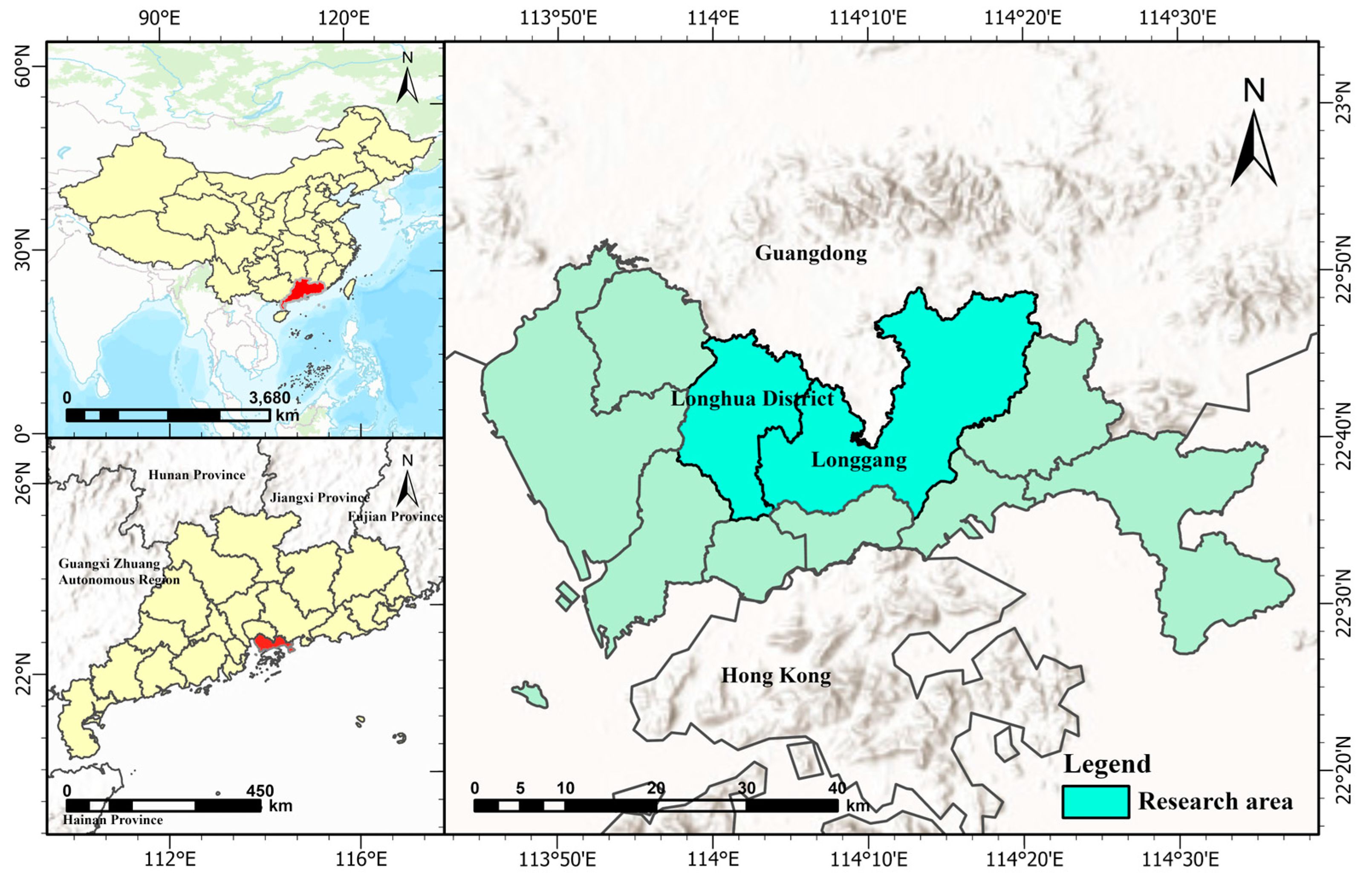
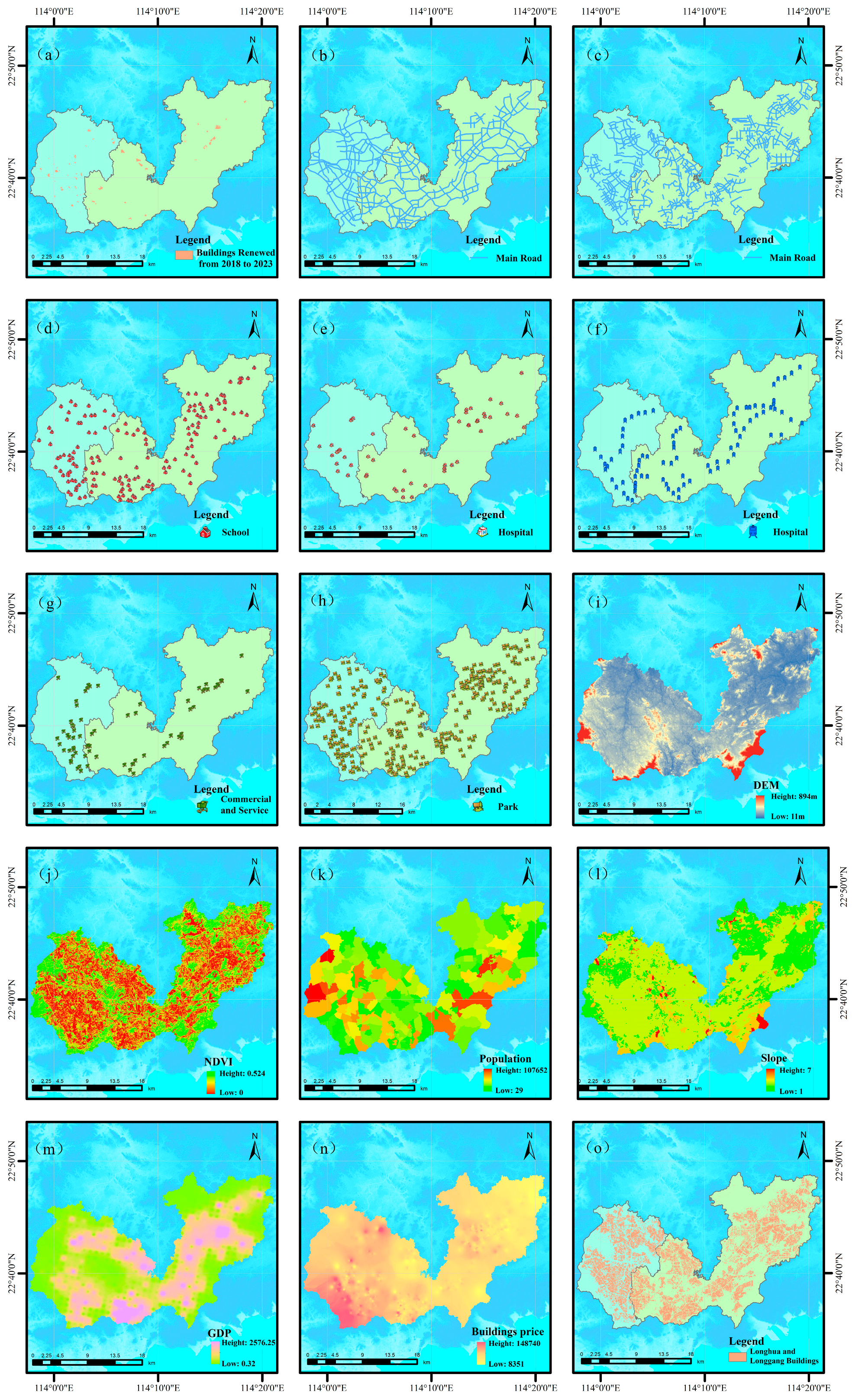
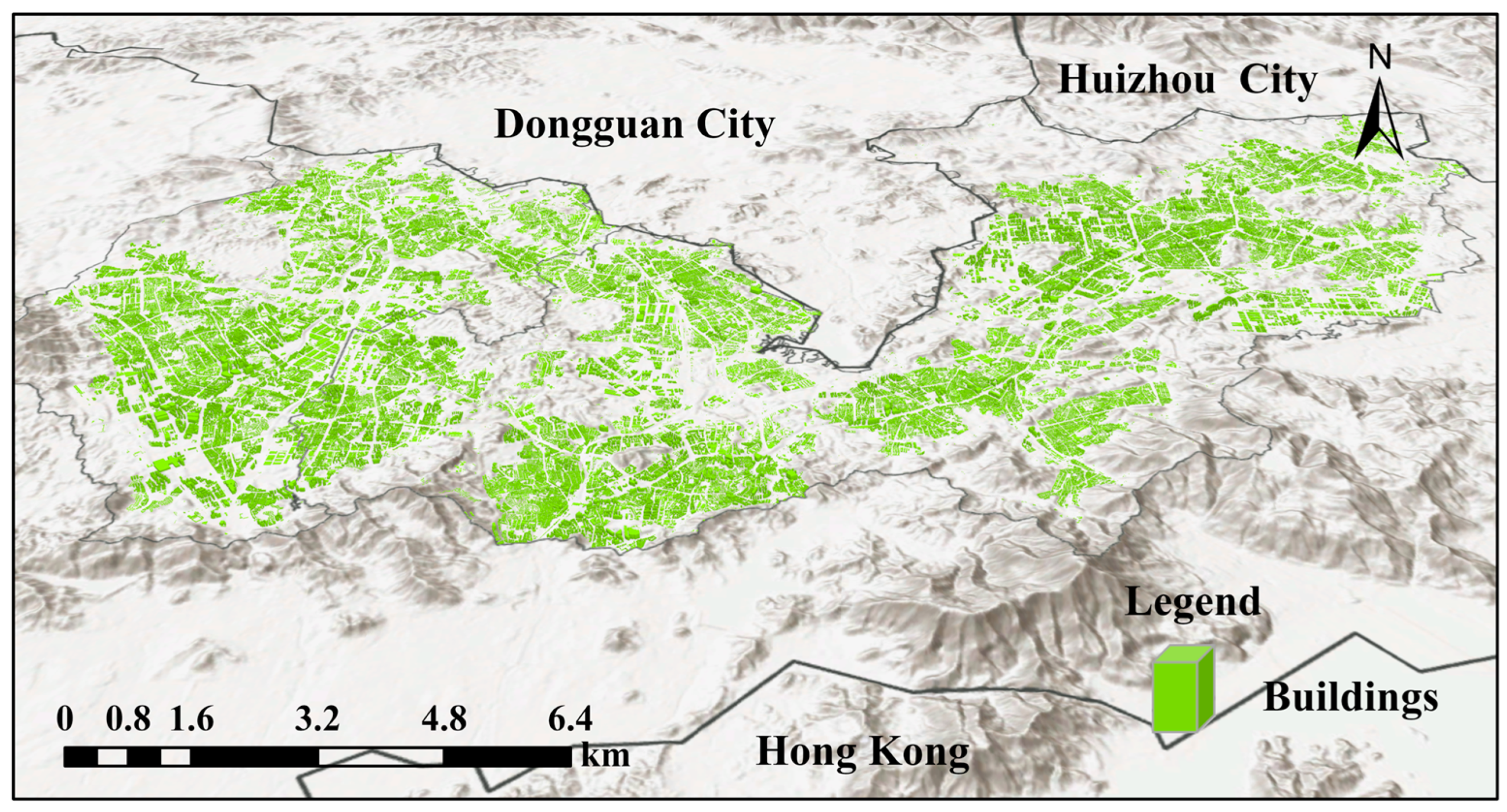

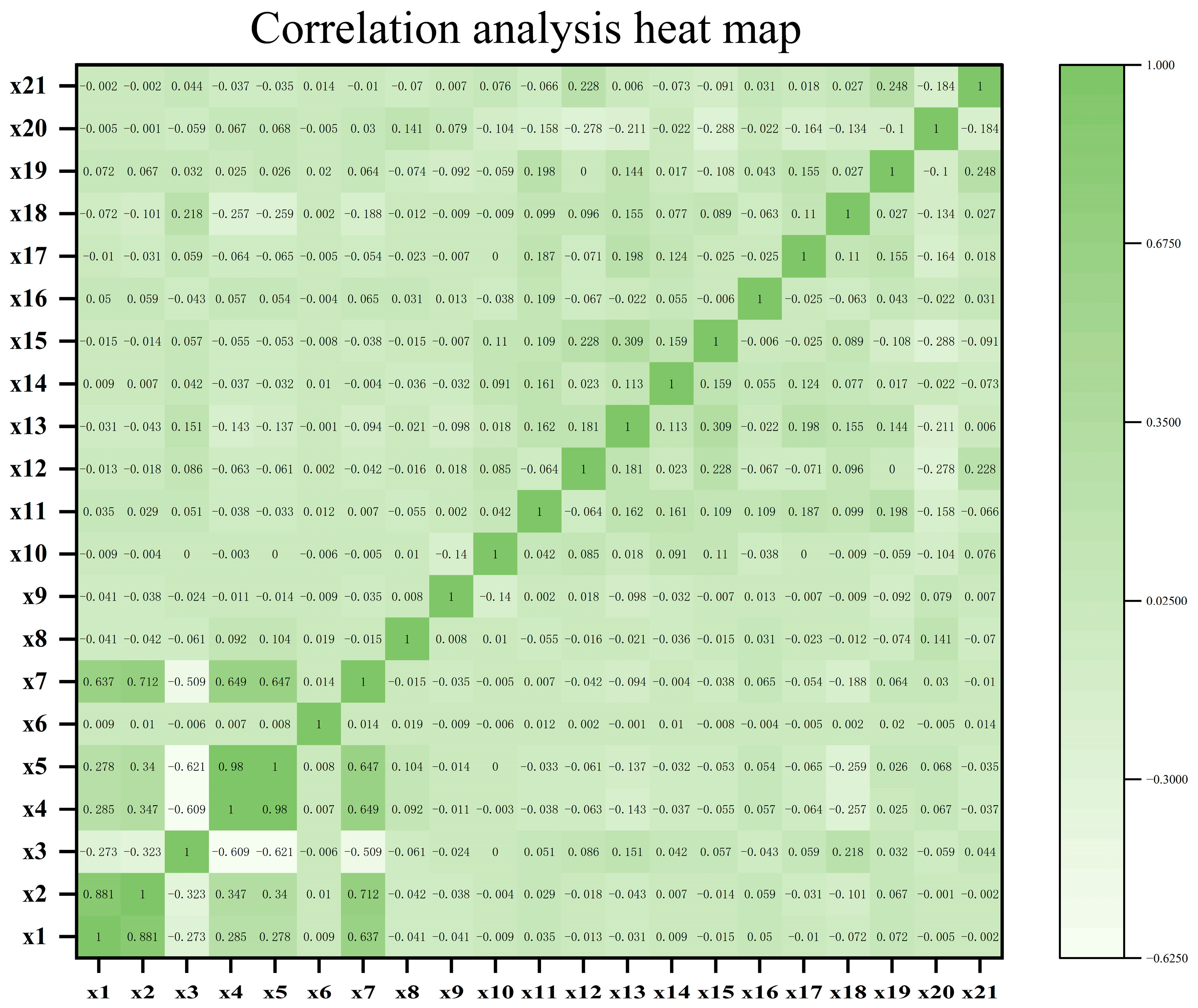

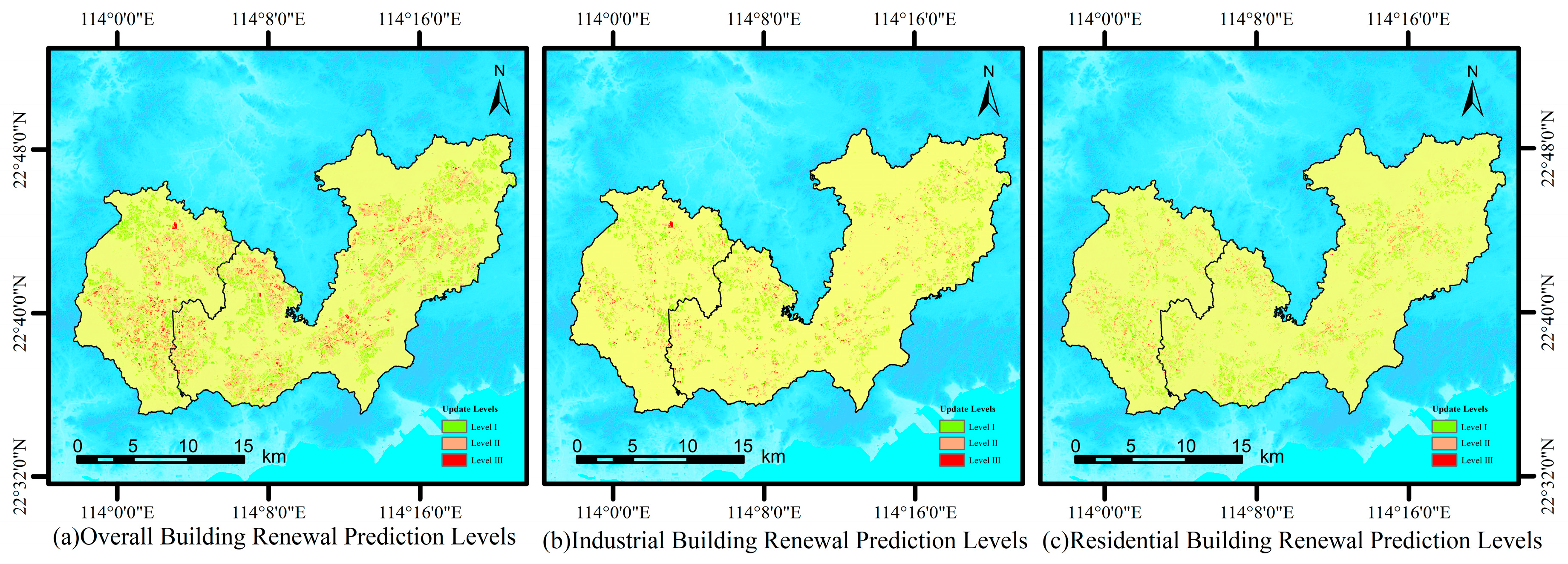

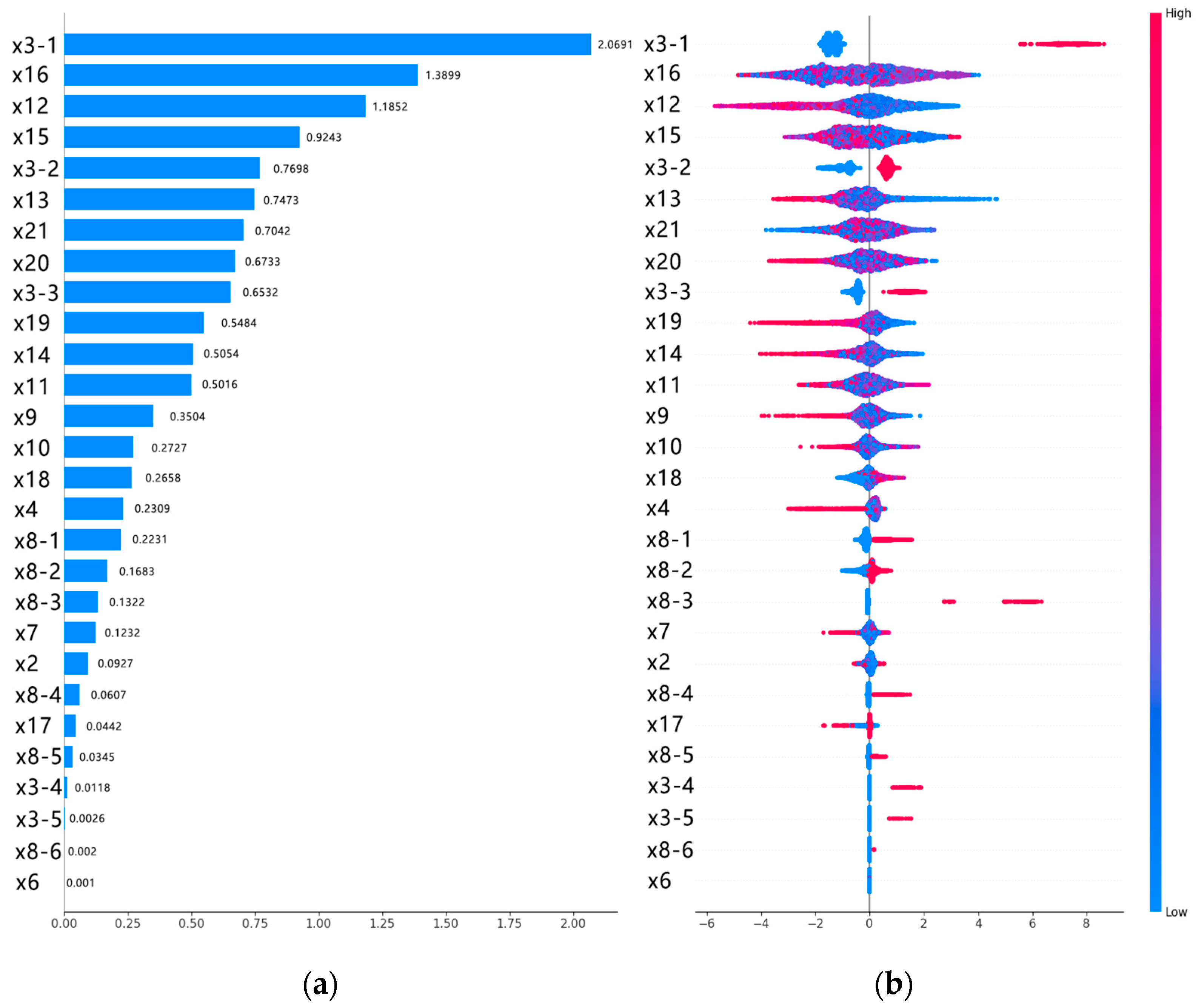
| Type | Name | Source |
|---|---|---|
| Vector Data | Shenzhen Administrative Division, Shenzhen Road Network System (Primary and Secondary Roads), Building Census Data, Population Census Data, Slope Data, Gross Domestic Product, Building Price | Shenzhen Planning and Natural Resources Bureau (https://pnr.sz.gov.cn) (accessed on 10 May 2024) |
| Open Internet Data | Urban renewal unit location information Shenzhen’s education, parks, hospitals, schools, and metro location information | Longgang District Urban Renewal and Land Preparation Bureau (https://www.lg.gov.cn) (accessed on 14 May 2024) Longhua District Urban Renewal and Land Preparation Bureau (https://www.szlhq.gov.cn) (accessed on 19 May 2024) Gaode Map API (https://lbs.amap.com)(accessed on 25 May 2024) |
| Image Data | Landsat 8 imagery data Historical remote sensing imagery DEM30m elevation data | Geospatial Data Cloud (https://www.gscloud.cn) (accessed on 2 June 2024) |
| Indicator Name | Overall Buildings in the Study Area | Updated Buildings in the Study Area |
|---|---|---|
| Building Quantity | 234,225 buildings | 22,733 buildings |
| Building Perimeter | 5.65–3327.55 m | 6.0–1178.8 m |
| Land Area | 1.9–193,474.9 m2 | 2.25–22,385.5 m2 |
| Structure Type | Steel structure, mixed structure, frame structure, tube structure, brick–concrete structure, brick–tile structure. | Steel structure, mixed structure, frame structure, tubular structure, brick–tile structure. |
| Height | 0~200.15 m | 0~27 m, accounting for 99.46%. |
| Number of Above-ground Floors | 0~56 floors | 0~9 floors; percentage: 99.13%. |
| Number of Underground Floors | 0~4 floors | 0~2 floors |
| Volume | 2.7 m2~651,429.7 m2 | 3.19~205,867.34 m2 |
| Building Function | Office, warehousing, warehousing and logistics, industrial, public facilities, public amenities, shopping centers, transportation, residential, residential amenities, commercial services, commercial streets, mixed-use, municipal facilities, private residences, special, integrated, others. | Warehousing, industrial, residential, residential amenities, commercial services, private residences; percentage: 99.27%. |
| Indicator Name | Overall Building Straight-Line Distance in the Study Area | Updated Building Straight-Line Distance in the Study Area |
|---|---|---|
| Main Road | 0.12–4327 m | 0.12–600 m, Percentage: 96.1% |
| Secondary Road | 0–3686 m | 0–500 m, Percentage: 95.96% |
| Indicator Name | Overall Building Straight-Line Distance in the Study Area | Updated Building Straight-Line Distance in the Study Area |
|---|---|---|
| Park | 1.45–4556.9 m | 1.15–1000 m, Percentage: 96.27% |
| Hospital | 29–4058 m | 47–1300 m, Percentage: 96.98% |
| School | 5.7–6629 m | 6.29–2000 m, Percentage: 86.15% |
| Commercial Facilities | 4.3–7868.6 m | 28–3000 m, Percentage: 95.97% |
| Subway | 39.7–6233.3 m | 28–2100 m, Percentage: 93.97% |
| Indicator Name | Overall Building Location in the Study Area | Updated Building Location |
|---|---|---|
| Population | 29–107,652 people | 20,000–80,000, Percentage: 88.5% |
| Slope | Level 1–7 | Level 1–3, Percentage: 99.47% |
| Vegetation (NDVI) | 0–0.38 | 0–0.25, Percentage: 96.30% |
| Elevation | 12–314 m | 20–80 m, Percentage: 93.4% |
| Gross Domestic Product | 0.32–4744.49 million yuan | 1.5–4115 million yuan |
| Building Price | 8351–148,740 yuan | 13,912–113,615 yuan |
| MLP | RF | SVM | XGBoost | Stacking | ||
|---|---|---|---|---|---|---|
| Overall prediction | Accuracy | 87.22% | 80.30% | 81.97% | 87.20% | 89.41% |
| Precision | 98.79% | 99.29% | 95.07% | 99.45% | 99.45% | |
| Recall | 75.37% | 61.04% | 67.45% | 74.81% | 79.26% | |
| F1 Score | 85.51% | 75.60% | 78.91% | 85.39% | 88.21% | |
| Industrial category prediction | Accuracy | 94.33% | 91.29% | 90.51% | 95.40% | 95.54% |
| Precision | 98.01% | 95.05% | 94.00% | 99.08% | 98.49% | |
| Recall | 90.51% | 87.11% | 86.54% | 91.64% | 92.49% | |
| F1 Score | 94.11% | 90.91% | 90.12% | 95.22% | 95.40% | |
| Residential category prediction | Accuracy | 88.45% | 81.80% | 85.14% | 89.11% | 89.55% |
| Precision | 97.95% | 98.55% | 95.81% | 99.72% | 99.72% | |
| Recall | 78.55% | 64.55% | 73.50% | 78.44% | 79.31% | |
| F1 Score | 87.18% | 78.00% | 83.19% | 87.81% | 88.36% | |
| Commercial category prediction | Accuracy | 84.07% | 76.11% | 83.63% | 82.74% | 81.42% |
| Precision | 96.39% | 96.83% | 94.19% | 96.25% | 98.63% | |
| Recall | 70.80% | 53.98% | 71.68% | 68.14% | 63.72% | |
| F1 Score | 81.63% | 69.23% | 81.41% | 79.19% | 77.42% |
| I Level | II Level | III Level | Total (Buildings) | |
|---|---|---|---|---|
| Overall Building Update | 124,731 | 63,243 | 18,696 | 206,670 |
| Industrial Building Update | 29,265 | 10,354 | 4724 | 44,343 |
| Residential Building Update | 98,429 | 34,167 | 15,651 | 148,247 |
Disclaimer/Publisher’s Note: The statements, opinions and data contained in all publications are solely those of the individual author(s) and contributor(s) and not of MDPI and/or the editor(s). MDPI and/or the editor(s) disclaim responsibility for any injury to people or property resulting from any ideas, methods, instructions or products referred to in the content. |
© 2024 by the authors. Licensee MDPI, Basel, Switzerland. This article is an open access article distributed under the terms and conditions of the Creative Commons Attribution (CC BY) license (https://creativecommons.org/licenses/by/4.0/).
Share and Cite
Sun, D.; Lu, Y.; Qin, Y.; Lu, M.; Song, Z.; Ding, Z. Method for Evaluating Urban Building Renewal Potential Based on Multimachine Learning Integration: A Case Study of Longgang and Longhua Districts in Shenzhen. Land 2025, 14, 15. https://doi.org/10.3390/land14010015
Sun D, Lu Y, Qin Y, Lu M, Song Z, Ding Z. Method for Evaluating Urban Building Renewal Potential Based on Multimachine Learning Integration: A Case Study of Longgang and Longhua Districts in Shenzhen. Land. 2025; 14(1):15. https://doi.org/10.3390/land14010015
Chicago/Turabian StyleSun, Dengkuo, Yuefeng Lu, Yong Qin, Miao Lu, Zhenqi Song, and Ziqi Ding. 2025. "Method for Evaluating Urban Building Renewal Potential Based on Multimachine Learning Integration: A Case Study of Longgang and Longhua Districts in Shenzhen" Land 14, no. 1: 15. https://doi.org/10.3390/land14010015
APA StyleSun, D., Lu, Y., Qin, Y., Lu, M., Song, Z., & Ding, Z. (2025). Method for Evaluating Urban Building Renewal Potential Based on Multimachine Learning Integration: A Case Study of Longgang and Longhua Districts in Shenzhen. Land, 14(1), 15. https://doi.org/10.3390/land14010015







